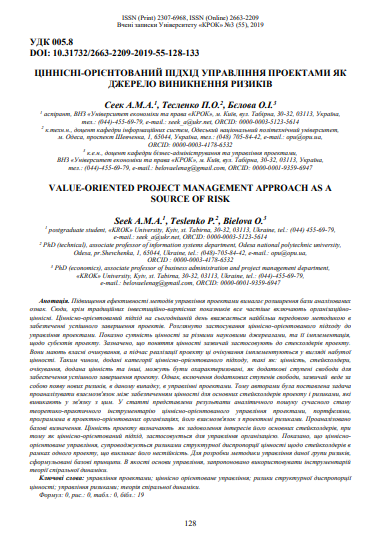VALUE-ORIENTED PROJECT MANAGEMENT APPROACH AS A SOURCE OF RISK
DOI:
https://doi.org/10.31732/2663-2209-2019-55-128-133Keywords:
project management, value oriented management, risks of structural value imbalances, management of risks, spiral dynamics theoryAbstract
Improving the effectiveness of project management methods requires expanding the base of the analyzed features. Here, in addition to traditional investment value indicators, they increasingly include organizational and value. Value-oriented approach today is considered the most advanced method in ensuring the successful completion of projects. Application of value-oriented approach to project management is considered. Indicative essence of value by various scientific sources, and its implementation, in relation to the subjects of the project. It is noted that the notion of value is usually applied to project stewards. They have their own proofs, and during the project implementation, these expectations are implemented in the form of acquired value. Thus, added value-based approach categories such as value, stakeholders, expectations, added value, and others can be characterized as additional degrees of freedom to ensure a successful completion of a project. However, the inclusion of additional degrees of freedom, as a rule, leads to the emergence of new risks, in this case, in project management. Therefore, the authors have been tasked to analyze the relationship between providing value for the main project stakeholders and the risks that arise in this regard. The article presents the results of the analytical search for the modern state of the theoretical and practical toolkit of value-oriented management of projects, portfolios, programs in project-oriented organizations, its relationship with project risks. Analyzed basic definitions. The value of the project as meeting the interests of its main stakeholders, and the value-oriented approach, as a rule, is used to manage the organization. It is shown that value-oriented management is accompanied by risks of structural value imbalance with respect to stakeholders in a single project, which causes its instability. For the development of management techniques for this group of risks, the basic principles are formulated. As the basis of control, it is proposed to use the tools of the theory of spiral dynamics.
Downloads
References
Бушуев С. Д., Бушуева Н. С. Механизмы формирования ценности в деятельности проектно-управляемых организаций. Восточно-европейский журнал передовых технологий. 2010. № 1/3 (43). С. 4-9.
Бушуев С. Д., Харитонов Д. А. Ценностный подход в управлении развитием сложных систем. Управління розвитком складних систем. 2010. Вип. 1. С. 10-15.
Ярошенко Ф. А., Бушуев С. Д., Танака Х. Управление инновационными проектами и программами на основе системы знаний : монографія. Київ : 2011. 263с.
A guide to the project management body of knowledge (PMBOK guide) / Newtown Square, PA : Project Management Institute, 2017.
Азарова І. Б. Ціннісно-орієнтований підхід в управлінні інвестиційнобудівельними проектами житлового будівництва : дис. … кан. тех. наук : 05.13.22 / ХНУМГ ім. Бекетова, Харків, 2016. 145 с.
Данченко О. Б., Бедрій Д. І., Семко І. Б. Управління конфліктами наукового проекту. Вісник національного технічного університету «ХПІ». Серія: Стратегічне управління, управління портфелями, програмами та проектами. 2019. № 2 (1327). С. 28-35.
Шерстюк О. І., Тесленко П. О. Аналіз компетенцій команди проекту при її взаємодії із зацікавленими сторонами. Управління проектами у розвитку суспільства : матеріали ХVI міжнародної конференції. Київ : КНУБА, 2019. С. 248 – 249.
Бушуев С. Д. Ценностный подход в управлении развитием проектно-ориентированных организаций. Технические науки - от теории к практике : матер. XII междунар. науч.-практ. конф. №3(28). URL : https://sibac.info/conf/tech/xxxii/37522.
Рач В. А. Методи оцінки альтернативних проектів стратегій регіонального розвитку. Управління проектами: стан та перспективи. Управління проектами: стан та перспективи : матеріали конференції. Миколаїв, 2009. С. 4-6.
Spiral Dynamics: Mastering Values, Leadership, and Change, Don Beck and Christopher Cowan, 1996.
Керцнер П. Стратегическое планирование для управления проектами с использованием модели зрелости: научное пособие. Москва : Компания АйТи;М.; ДМК Пресс, 2003. 320 с.
Teslenko P., Antoshchuk S., Krylov V. Increasing probability of successful projects complete. Proceedings of the International Research Conference at the Dortmund University of Applied Sciences and Arts took place. June 30th - July 1st 2017 for the seventh time. 2017. Dortmund : the Dortmund University. P. 28-30.
Дегтярев М. А. Проектная зрелость и ценностно-ориентированное управление проектами. URL : http://www.i-mash.ru/materials/economy/64524-proektnaja-zrelost-i-cennostno-orientirovannoe.html.
Метод формирования портфеля проектов на основе доминирующих ценностей организации. Universum: Технические науки. 2014. № 2 (3). URL : http://7universum.com/ru/tech/archive/item/1033.
Данченко Е. Б., Дзюба Т. В. Использование маркетинговых инструментов идентификации ценностей в проектах. Управление проектами и развитие. 2012. № 3 (43). С. 21-28.
Драч І. Є., Рулікова Н. С. Розробка механізму системно-ціннісного формування портфелю наукових проектів вищого навчального закладу. Управління проектами та розвиток виробництва. 2013. №2(46). С. 100-107. URL : http://www.pmdp.org.ua/
Григорян Т. Г., Кошкин В. К. Совершенствование моделей ценностно-ориентированного управления портфелями проектов реконструкции систем водоснабжения. Восточно-Европейский журнал передовых технологий. 2015. № 2/3 (74). С. 43 – 49.
Питерская В. М. Ценностный подход в управлении развитием проектно-ориентированной организации. Вісник Одеського національного морського університету. 2014. № 3 (42). С. 172–180.
Чимшир В. И., Тесленко П. А. Проект как система : монография. Одесса : Институт креативных технологий, 2011. 159 с.


